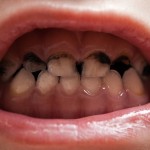
Identifying children at greatest risk of caries in order to optimize preventive activity has been a goal of the dental profession for many a long year and a number of reviews of potential risk factors have been conducted ( see Dental Elf 10th Dec 2012). This study aimed to assess a number of caries risk assessment (CRA) programmes and compare their validity. The programmes tested were, the Caries-risk Assessment Tool (CAT), the Caries Management by Risk Assessment (CAMBRA) programme, the Cariogram, and the National University of Singapore Caries Risk Assessment (NUS-CRA) models.
544, children aged 3- were examined by a calibrated examiner dental caries and oral hygiene status was evaluated. Salivary and microbiological tests were taken a questionnaire was used to assess socio-economic status, oral health and health behaviours. The child’s caries assessed using the 4 test programmes CAT, CAMBRA, Cariogram and NUS-CRA. Dental status was re-evaluated at 12 months by the same examiner. The study took place in Hong Kong where water is fluoridated at 0.5ppm
- 485 children were examined (89%) at 1 year
- The sensitivities and specificities of each program were calculated at a number of cut off points (see table).
[table id=42/]
The authors concluded
Our findings supported the algorithm-based modeling for caries prediction. NUS-CRA appeared to be a useful programme with sufficient sensitivity and specificity in Hong Kong children. Studies in other populations may further shed light on the robustness of this programme.
Comment
Each of the programmes assessed a number of potential risk factors, The NUS-CRA (11 items), the Cariogram ( 9 items) , CAT (12 items), and CAMBRA (14 items). When assessing a diagnostic test ideally you would be looking for 100% sensitivity and 100% sensitivity, this almost never happens so we tend to look for trade offs as increased sensitivity usually means more false positive tests potentially leading to unnecessary interventions. Low specificity will lead to to many false negatives. An alternative way of assessing a test is to use the likelihood ratio (LR). This can be calculated from the sensitivity and specificity values. From the table it can be seen that the NUS-CRA screening and comprehensive tools had the highest LR . As an example if you thought that your patient had a 20% chance of developing caries running the comprehensive NUS-CRA (LR= 5) would give you an estimate that their risk of developing caries within the year was around 55%. .Tests with LR of one a of limited value in this case . As a rule of thumb you would like to see a LR of more than 10.
Links
Gao X, Di Wu I, Lo EC, Chu CH, Hsu SC, Wong MC. Validity of caries risk assessment programmes in preschool children. J Dent. 2013 Jun 19. doi:pii: S0300-5712(13)00154-1. 10.1016/j.jdent.2013.06.005. [Epub ahead of print] PubMed PMID: 23791698.
Dental Elf 10th Dec 2012 – Risk factors for early childhood caries
Diagnostic and likelihood ratios explained (from the NNT website )
